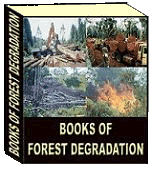| Forest Degradation
May be generally defined as a reduction in tree density and/or increased disturbance to the forest that results in the loss of forest products and forest-derived ecological services. The FAO defines degradation as changes within the forest class (for example, from closed to open forest) that negatively affect the stand or site and, in particular, lower production capacity. Common causes of forest degradation include selective felling, fuelwood collection, road building, and shifting cultivation.

Human activities have had tremendous impact on modern forests. Since agriculture began about 11,000 years ago, large forest areas have been cleared for farms and cities. Beginning in the 1800's, great expanses of forest have also been eliminated because of logging and industrial pollution. The destruction and degrading of forests is called deforestation.
Deforestation
The permanent removal of forest cover and conversion of the land to other uses. According to the land use definition used by FAO and accepted by most governments, forest land that has been harvested, even clear-cut, is not regarded as deforested because, in principle, trees may regrow or be replanted. Deforestation is recorded only when the land is permanently converted to non-forest use. However, the remote sensing imagery used in this report to determine land cover (the presence or absence of forest) over time does not make such a distinction and clear-cut land has been recorded as non-forest or deforested land.
|
